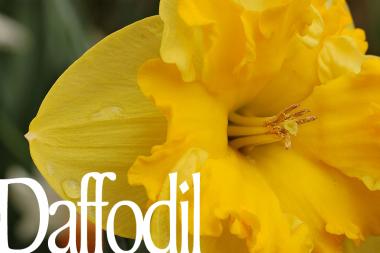
Daffodil, narcissus, jonquil, Lent lily, Easter bells, whatever you call it, this little yellow wonder is one of the most popular springtime flowers of all time! Maybe it’s because when the daffodils are in bloom we all know it’s the beginning of spring and warm weather. (And I know we are all ready for that!)
The original name for the daffodil was ‘affodyll.’ The ‘D’ is somewhat of a mystery, but it’s believed to be a merger with the Dutch article ‘de’ as in ‘de affodyll.’ They also have the cute little nickname ‘daffadowndilly’ and white ones are sometimes called ‘paperwhites.’
DAFFODIL /
NARCISSUS
Scientific name: Narcissus
Use: Flower
Type: Bulbous Perennials
Height: 6-30″‘
Astrological Flower: December Flower
GROWING
Planting Zones: 4-10
Requirements: Well-drained, slightly acidic soil. Full sun is also required, but very easily achieved. When these are in bloom, most trees are still bare.
DESIGNING
Stem: 8-32″
Blossom Size: 2-5″
Texture: Satin
Silhouette: Solid/ Cup
Vase Life: 3-7 Days, keep growing in vase
Colors: Yellow, white, and orange
Bloom Season: Late winter, early spring
Flowers Available: Year Round
HISTORY OF DAFFODILS
There are two legends of note about the origins of the daffodil, each being very different. It seems this flower has different meanings for different cultures of the world. For the West, it’s vanity, and the East it means fortune and prosperity.
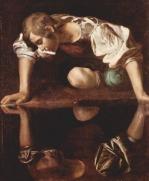
The first legend is one you might be familiar with: it begins with a young Greek boy named Narcissus who was completely obsessed with himself and his beauty. (As you might have guessed, this is where we get the concept of narcissism.) One day, the boy found a small pond where he was able to see his reflection; he was so completely engrossed with himself he refused to leave and died of starvation. The gods turned the boy’s remains into the first “Narcissus” flower and that is the origin of the lovely flower we see today.
The second legend comes from Chinese culture and is a little more positive. It is said that a poor but good man was given cups of gold every morning from this flower.
I also found a story about two brothers who were given land from their dying father. One brother seized the good, hardy land; the other got the rocky leftovers. The poor brother found the beautiful daffodil flower on his land and begin to cultivate it. The bulbs did very well and brought him fortune. The evil brother was jealous and bought as many bulbs as he could to cash in on his brothers fortune. The greedy brother’s bulbs ended up dying and the good brother was able to buy back his father’s land.
The daffodil is the official flower of Whales, and on March 1st it is custom to wear a daffodil in honor of St. David’s Day. It is also a Welsh custom; whomever sees the first daffodil of the year will be blessed with prosperity for the next 12 months.
The East has a long history with the narcissus. It is one of the most highly revered flowers and the symbol of the Chinese New Year.
Daffodils seem to symbolize both good and bad fortune. When giving daffodils, take extra care to give a bunch, giving one can bring bad fortune.
TAKE CAUTION WITH DAFFODILS
You may not know this, but daffodils are actually quite toxic. Florists sometime get daffodil itch: dryness, fissures, scaliness on the hands and thickness under the nails due to exposure to calcium oxalate in the sap. The plant itself is only slightly toxic, but the bulb is very dangerous.
FLORIST TIP — Daffodils secrete a substance that is damaging to other flowers sharing the same water in a vase. Keep them separate for at least 24 hours before putting daffodils with other flowers. Change the water often to keep the secretion from damaging other flowers.
Roman soldiers used to carry a satchel of daffodil bulbs with them into battle. If they were injured to the point of death, they would eat these toxic bulbs to relieve pain and hasten death.
According to the BBC, in May 2009 a number of school children fell ill at a school in Suffolk, England after mistaking a daffodil bulb for an onion and adding it to soup during a cooking class. The kids were taken to a hospital as a precautionary measure, but were soon allowed to return home.
TYPES OF DAFFODILS
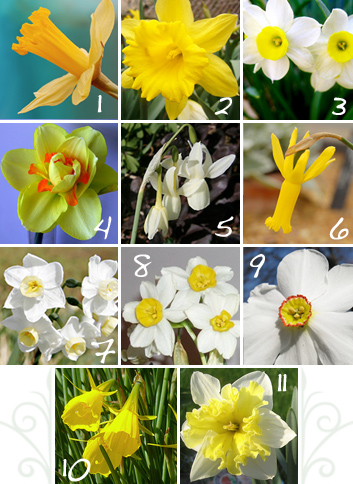
Daffodils come in hundreds of styles and colors. For horticultural purposes they are divided into 13 divisions. The above diagram shows the divisions, or the basic shape types of daffodils.
Division 1: Trumpet — Solitary flowers with trumpets or cups as large or larger than the petals of the flower.
Division 2: Large-cupped — Solitary flowers with a short, large cup.
Division 3: Small-cupped — Solitary flowers with a small, short cup.
Division 4: Double — Stems have one or more flowers and a doubling or more of the cup.
Division 5: Triandrus — Stems have 2 to 6 flowers, usually short cups, and the petals are reflexed, or reversed.
Division 6: Cyclamineus — Solitary flower with it’s stem angled downward, as well as reflexed petals.
Division 7: Jonquilla — Stems have 1 to 5 flowers with very small cups.
Division 8: Tazetta — Small-flowered Tazetta division can have up to 20 flowers per stem, larger ones have only 3 or 4. They have small cups.
Division 9: Poeticus — Solitary flower with pure white petals and a tiny, red-ringed cup.
Division 10: Bulbocodium — Includeds all wild daffodils and their wild hybrids.
Division 11: Split-corona — Usually solitary flowers with a split corona, or cup.
Division 12: Miscellaneous — Includes all daffodils not in other divisions.
Division 13: Daffodils distinguished by their botanical name only.
EXTREME DAFFODILS
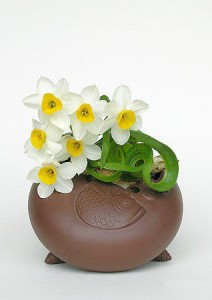
Chinese Bulb Carving
Like the practice of bonsai, the narcissus also has a special art associated with it. Chinese bulb carving is a very, very rare and extraordinary skill. A skilled carver is able to open a mature narcissus bulb and predict exactly what the future plant will look like. They know exactly how many shoots it will have. Like a C-section, the carver will delicately cut into the bulb without damaging any of the life-giving water pouches, and scab the future shoots, forcing them to grow curly. It takes years to master this very difficult art.
Daffodil Poetry
You may have learned this in school, I did, but we learned a lot of poetry. This is one of my favorites:
“Daffodils” (1804)
I WANDER’D lonely as a cloud
That floats on high o’er vales and hills,
When all at once I saw a crowd,
A host, of golden daffodils;
Beside the lake, beneath the trees,
Fluttering and dancing in the breeze.
Continuous as the stars that shine.
And twinkle on the Milky Way,
They stretch’d in never-ending line
Along the margin of a bay:
Ten thousand saw I at a glance,
Tossing their heads in sprightly dance.
The waves beside them danced; but they
Out-did the sparkling waves in glee:
A poet could not but be gay,
In such a jocund company:
I gazed — and gazed — but little thought
What wealth the show to me had brought:
For oft, when on my couch I lie
In vacant or in pensive mood,
They flash upon that inward eye
Which is the bliss of solitude;
And then my heart with pleasure fills,
And dances with the daffodils.
By William Wordsworth (1770-1850).
Send Daffodils To your Loved One Today


 Find Your
Find Your 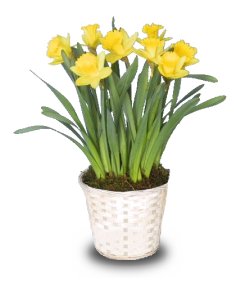
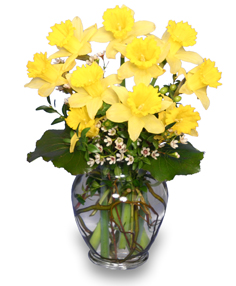


Speak Your Mind